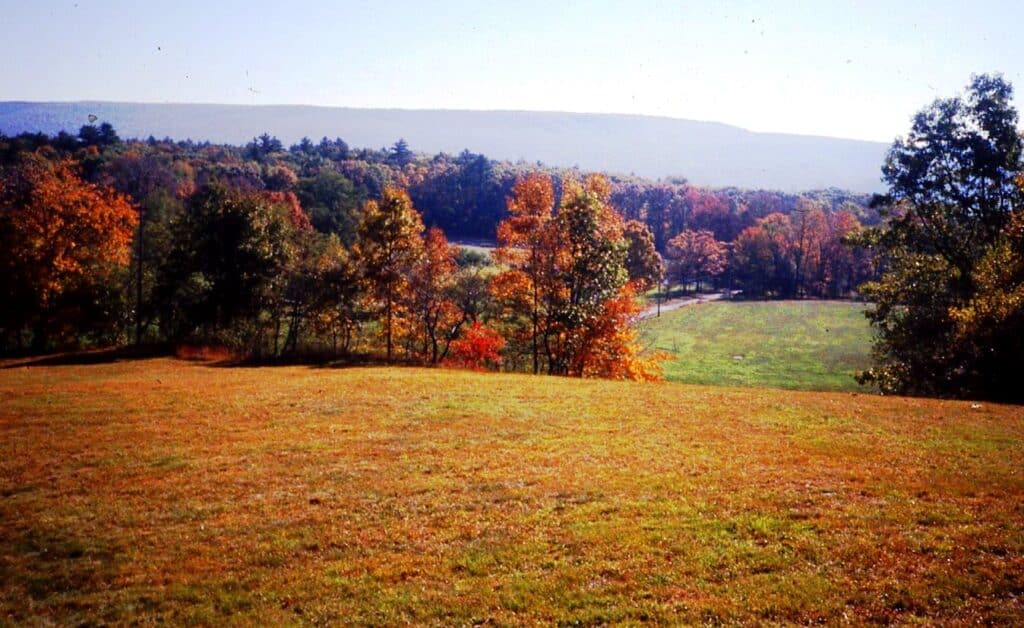Acknowledging the Lenni-Lenape Native Americans
Camp Deerpark is nestled in the Shawangunk Mountains on the land that was once the home of the Lenape (len-AH-pay) or Lenni-Lenape Native American peoples. The Munsee, a subtribe of the Lenape, lived along the upper portion of the Delaware River. Shawangunk is a Dutch translation of the indigenous Munsee name “schawank,” meaning “that which is smoky air.” The Shawangunk area can be noted for the heavy humidity and atmosphere caused by the mountain ridge running southwest to northeast partially blocking the prevailing west to east wind. Camp Deerpark staff and guests have long appreciated the breathtaking view when driving into the Shawangunk valley on Route 17.
The land of the Lenape included what we know as eastern Pennsylvania; southeastern New York state, including New York City; New Jersey; northern Delaware and a small area of southeastern Connecticut. This land was called the Lenapehoking (meaning “Land of the Lenape”) and the land was split between three clans or geographical divisions of the Delaware region: Turtle, Wolf and Turkey. The Wolf clan was known as the Munsee or Minisink, which means “at a place where stones are gathered together.”
The Lenape believed that the land was sacred and belonged to everyone. They usually lived in small groups of 25 to 50 people. They built wigwam–domed-shaped houses–which were 20 feet across and made from young saplings and bark stripped from large trees. They also lived in longhouses, which were built like wigwams but longer, with room for multiple families. Family ties were important and close relationships existed between parents and children and related clans.
The chiefs—sometimes referred to as sachems—were chosen for their behavior, skill in speaking, honesty, and ability to make wise decisions. The chiefs were also knowledgeable about religion and would lead the people in rituals and ceremonies.
The Lenape men were hunters, but also prepared the land for gardening. Children moved the small rocks away and pulled any weeds. Women planted and harvested the crops and were creative in their methods of planting. To plant corn, beans and squash, their most important crops, the soil was hoed into mounds about three feet in diameter, then planted with five or six corn seeds in a circle at the very top of the mound. About a foot lower on the mound, they planted beans about six inches apart in another circle and finally around the outer edge they planted a circle of squash. This is called the Three Sister’s Garden. The beans climbed the corn and the squash covered the ground holding in moisture. They planted these gardens several weeks apart so they would have fresh vegetables throughout the summer and fall. The women were also responsible to collect sap from maple trees to make maple syrup.
The men would hunt deer and elk in the forest with bows and arrows. They painted themselves with dark paint to blend in with the shadows. When they would bring the animal back to the village, the Lenape would make sure to use all parts of the animal to honor the kill. Other men would fish with nets and hollowed out tree trunks used as canoes in the tributaries of the Delaware and the Neversink rivers. The Lenape enjoyed a wide variety of food, which was distributed and shared so that no one went hungry.
When the Europeans settled here in the late 1600s and early 1700s, they began to call the tribe the “Delaware Indians” as they had trouble pronouncing Lenape. The settlers generally lived in peace alongside the Lenape near the Peenpack Trail. The Europeans had moved from France to get away from the religious persecution that occurred when King Louis XIV revoked the Edict of Nantes, the law which let the Huguenots practice their religion. The Huguenots were Protestants and a branch of Calvinism. They traveled in covered wagons on Old Mine Road, which is now Route 209. They officially owned the land that they settled on in 1697 by getting the Peenpack Patent. This granted them the 1,200 acres from where Route 209 crosses the Neversink River, about three miles south of Camp Deerpark.
In the fall of 2007, soon after Rick Weaver joined the Camp Deerpark staff as the food service director, he spent an afternoon hiking in the woods. He was struck by the rich history represented in the stone walls throughout the camp property. His curiosity led him to carry out extensive internet research. He soon had a new source to draw from. Town of Deerpark, a history book written by Norma Schadt, was published a year later.
In the spring of 2008 Rick prepared a Saturday evening dinner that reflected his research. The menu read: 300 years ago . . . on this site, we might have eaten: Pumpkin Soup, Skillet Cornbread with Maple Butter, Shawangunk Salad (wild greens, watercress, dill weed, corn, tomato, radish, red beans, sunflower seeds, with a honey vinaigrette dressing), Hog Wild BBQ Loin, Sour Cream & Horseradish Mashers, Msikwatash of the Three Sisters(corn, beans, squash), Munsee Cherry Pudding Cake.
The Lenape and the Europeans learned a lot from each other. For example, the Lenape began to use European metal field tools to help plant crops. The later generations of the European settlers even learned how to communicate using the Lenape language and they adopted some of the ways of Lenape dress, like using leather for their shoes and clothes.
The European settlers included families named Cuddeback and West-brook. Mr. Westbrook ran a general store near his house. Four miles south of the Westbrook Store, Mr. Cuddeback built a gristmill near his house where he would grind the grain for the neighbors. Today Camp Deerpark is located halfway between Westbrookville and Cuddebackville.
During the French and Indian and Revolutionary wars, the Lenape often fought beside their European allies and against each other. Eventually, the Lenape were driven from their land and moved out west, including to Oklahoma, and north into Canada, where the majority of the Lenape live today.
Even so, the Lenape legacy in this region lives on for those who remember, in part through language. Many place names come from the Lenape, such as Hackensack, Manasquan and Manhattan.
—Written by Dillon Hershey, Ken Bontrager, and Donna Stoltzfus
Related Entries
Share:
“How Do I Donate?”
Recently, a thirteen-year-old guest at Camp asked Operations Director Kevin Smith, “how do I donate?” Kevin was honestly a little surprised, but was happy to see this young member – who was on retreat with one of our owning churches — taking some initiative. Kevin directed him to the website Donate page, and the young…
The Discipleship Down-Low
Defining Discipleship 18 And Jesus came and said to them, “All authority in heaven and on earth has been given to me. 19 Go therefore and make disciples of all nations, baptizing them in the name of the Father and of the Son and of the Holy Spirit, 20 teaching them to observe all that I have commanded…
The Virtuous Wife
This past weekend, Camp hosted three women’s retreats at Camp. Though the retreat groups were very diverse in background – one was from an urban church plant in Philadelphia, one was from a Garifuna Mennonite church in Brooklyn (an Afro-Caribbean Culture), and one was from a multi-ethnic faith community reaching out in North Jersey. Though…
A Life of Service
I believe the most important thing to God is not our personality, knowledge, or talents, but our availability. How willing and ready are we to respond when He calls, and how ready are we to do what He says? What use to the Lord are people who could do what he wants with excellence and…
Building Belonging
At our February NYC LMC District meeting, we’re discussing the Belonging phase of The Journey Map. In this first phase on the map, individuals and groups on a spiritual journey begin the process of connecting to each other and evaluating the place they may have in each other’s lives. Have you ever been an outsider…
What Are You Tapped Into?
Yesterday we began tapping maple trees, officially opening maple syrup making season at Camp Deerpark! Last year, the transition kept us from producing syrup, so it feels great to be back to it. Starting off, however, has been a bit of a challenge since things are pretty arctic around here. The entire ground is covered…
What Does it Mean to be Spirit-Led with Pastor Mark Perri
One small contribution I can make is to share story with you. This could be valuable in several ways: First, I’m coming to the Mennonites from the outside — from non-denominational GenX “simple/ organic/ emergent church“. Sometimes people coming from outside-in have a helpful perspective for those trying to move from inside-out. Second, as an…
2025 NYC LMC District Call Schedule
Mark these dates in your calendar if you’re part of the NYC LMC District and want to attend the English-language fellowship and resourcing calls led by Bishop Hyacinth Stevens: January 27th – 6:30 PM February 24th – 6:30 PM March 31st – 6:30 PM April 28th – 6:30 PM May 19th – 6:30 PM June 30th…
Winter: Life Under the Surface
On the surface, winter with its cracking and cold seems like the enemy of life. Everything sleeps as though dead, and Camp — quiet and empty — sits waiting. But under the surface, winter is revealed to be a friend to life, not an enemy. In the deep frost, God opens the soil for Spring’s…
Peace Making Presents
This is Session 4 of the Prince of Peace: Jesus and Peacebuilding from the Election to the Holidays webinar series. Advent celebrates the central fact that God began building peace with us by giving a Gift. Following this example, gifts are a powerful tool for peacebuilding in our lives, relationships, and organizations. We’ll explore how…



